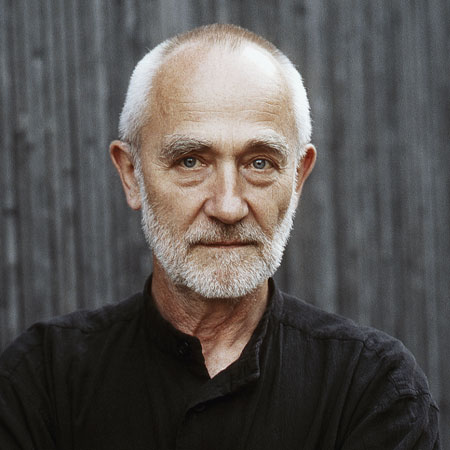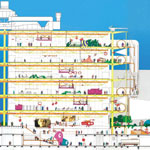
Peter Zumthor wins Pritzker Prize
Swiss architect Peter Zumthor has been named 2009 Pritzker Architecture Prize Laureate.
Portrait by Gary Ebner. Update 18/04/09: see an overview of Zumthor's best buildings in our new story.
Below is the announcement; more info and images on the Pritzker Prize website:
--
Peter Zumthor of Switzerland Becomes the 2009 Pritzker Architecture Prize Laureate
Los Angeles, CA—Peter Zumthor of Switzerland has been chosen as the 2009
Laureate of the Pritzker Architecture Prize. The formal ceremony for what has come to be known throughout the world as architecture’s highest honor will be held on May 29 in Buenos Aires, Argentina. At that time, a $100,000 grant and a bronze medallion will be bestowed on the 65-year old architect.
Although most of his work is in Switzerland, he has designed projects in Germany, Austria, The Netherlands, England, Spain, Norway, Finland and the United States. His most famous work is in Vals, Switzerland — the Thermal Baths, which has been referred to by the press as “his masterpiece.” Most recently critics have praised his Field Chapel to Saint Nikolaus von der Flüe near Cologne, Germany. The jury singled out not only those buildings, but also the Kolumba Museum in Cologne, calling the latter “a startling contemporary work, but also one that is completely at ease with its many layers of history.”
In announcing the jury’s choice, Thomas J. Pritzker, chairman of The Hyatt Foundation, quoted from the jury citation, “Peter Zumthor is a master architect admired by his colleagues around the world for work that is focused, uncompromising and exceptionally determined.” And he added, “All of Peter Zumthor’s buildings have a strong, timeless presence. He has a rare talent of combining clear and rigorous thought with a truly poetic dimension, resulting in works that never cease to inspire.”
In Zumthor’s own words as expressed in his book, Thinking Architecture, “I believe that architecture today needs to reflect on the tasks and possibilities which are inherently its own. Architecture is not a vehicle or a symbol for things that do not belong to its essence.
In a society that celebrates the inessential, architecture can put up a resistance, counteract the waste of forms and meanings, and speak its own language. I believe that the language of architecture is not a question of a specific style. Every building is built for a specific use in a specific place and for a specific society. My buildings try to answer the questions that emerge from these simple facts as precisely and critically as they can.”
Pritzker Prize jury chairman, The Lord Palumbo elaborated with more of the citation: “Zumthor has a keen ability to create places that are much more than a single building. His architecture expresses respect for the primacy of the site, the legacy of a local culture and the invaluable lessons of architectural history.” He continued, “In Zumthor’s skillful hands , like those of the consummate craftsman, materials from cedar shingles to sandblasted glass are used in a way that celebrates their own unique qualities, all in the service of an architecture of permanence.”
Zumthor, when notified that he had been named the 2009 laureate, responded, “Being awarded the Pritzker Prize is a wonderful recognition of the architectural work we have done in the last 20 years. That a body of work as small as ours is recognized in the professional world makes us feel proud and should give much hope to young professionals that if they strive for quality in their work it might become visible without any special promotion.”
The Zumthor choice marks the second time in three decades of the Pritzker Architecture Prize that Switzerland has provided the laureate. In 2001, Jacques Herzog and Pierre de Meuron were the honorees.
The purpose of the Pritzker Architecture Prize is to honor annually a living architect whose built work demonstrates a combination of those qualities of talent, vision and commitment, which has produced consistent and significant contributions to humanity and the built environment through the art of architecture.
The distinguished jury that selected Zumthor as the 2009 Laureate consists of its chairman, Lord Palumbo, internationally known architectural patron of London, chairman of the trustees, Serpentine Gallery, former chairman of the Arts Council of Great Britain, former chairman of the Tate Gallery Foundation, and former trustee of the Mies van der Rohe Archive at the Museum of Modern Art, New York; and alphabetically: Alejandro Aravena, architect and executive director of Elemental in Santiago, Chile; Shigeru Ban, architect and professor at Keio University, Tokyo, Japan; Rolf Fehlbaum, chairman of the board, Vitra in Basel, Switzerland; Carlos Jimenez, professor, Rice University School of Architecture, principal, Carlos Jimenez Studio in Houston, Texas; Juhani Pallasmaa, architect, professor and author of Helsinki, Finland; Renzo Piano, architect and Pritzker Laureate, of Paris, France and Genoa, Italy; and Karen Stein, writer, editor and architectural consultant in New York. Martha Thorne, asssociate dean for external relations, IE School of Architecture, Madrid, Spain, is executive director.
“There have been two Pritzker Prize Laureates from South America, but we have never held the ceremony there,” explained Pritzker. “The first was Oscar Niemeyer of Brazil in 1988, and then another Brazilian in 2006, Paulo Mendes da Rocha. We held their ceremonies in Chicago and Istanbul respectively. The venues change every year, moving around the world focusing on historic and architecturally significant sites. We’ve held ceremoies in Asia, Europe and North America, including Mexico, so it is time to visit South America.”
The late Philip Johnson was the first Pritzker Laureate in 1979. The late Luis Barragán of Mexico was named in 1980. The late James Stirling of the United Kingdom was elected in 1981, Kevin Roche in 1982, Ieoh Ming Pei in 1983, and Richard Meier in 1984. Hans Hollein of Austria was the 1985 Laureate. Gottfried Böhm of Germany received the prize in 1986. The late Kenzo Tange was the first Japanese architect to receive the prize in 1987; Fumihiko Maki was the second from Japan in 1993; and Tadao Ando the third in 1995. Robert Venturi received the honor in 1991, and Alvaro Siza of Portugal in 1992. Christian de Portzamparc of France was elected Pritzker Laureate in 1994. The late Gordon Bunshaft of the United States and Oscar Niemeyer of Brazil, were named in 1988. Frank Gehry of the United States was the recipient in 1989, the late Aldo Rossi of Italy in 1990. In 1996, Rafael Moneo of Spain was the Laureate; in 1997 the late Sverre Fehn of Norway; in 1998 Renzo Piano of Italy, in 1999 Sir Norman Foster of the UK, and in 2000, Rem Koolhaas of the Netherlands. In 2001, two architects from Switzerland received the honor: Jacques Herzog and Pierre de Meuron.
Australian Glenn Murcutt received the prize in 2002. The late Jørn Utzon of Denmark was honored in 2003; Zaha Hadid of the UK in 2004; and Thom Mayne of the United States in 2005. Paulo Mendes da Rocha of Brazil was the Laureate in 2006, and Richard Rogers received the prize in 2007. Jean Nouvel of France was the Laureate last year.
The field of architecture was chosen by the Pritzker family because of their keen interest in building due to their involvement with developing the Hyatt Hotels around the
world; also because architecture was a creative endeavor not included in the Nobel Prizes.
The procedures were modeled after the Nobels, with the final selection being made by the international jury with all deliberations and voting in secret. Nominations are continuous from year to year with hundreds of nominees from countries all around the world being considered each year.
Previous Pritzker Prize winners on Dezeen:
.

